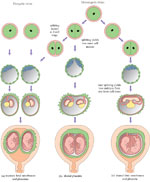8.7.1 Types of twin pregnancy
Twins may be identical (monozygotic) or non-identical and fraternal (dizigotic). Monozygotic twins develop from a single fertilised ovum (the zygote), so they are always the same sex and they share the same placenta. By contrast, dizygotic twins develop from two different zygotes, so they can have the same or different sex, and they have separate placentas. Figure 8.8 shows the types of twin pregnancy and the processes by which they are formed.
8.7 Multiple pregnancy

